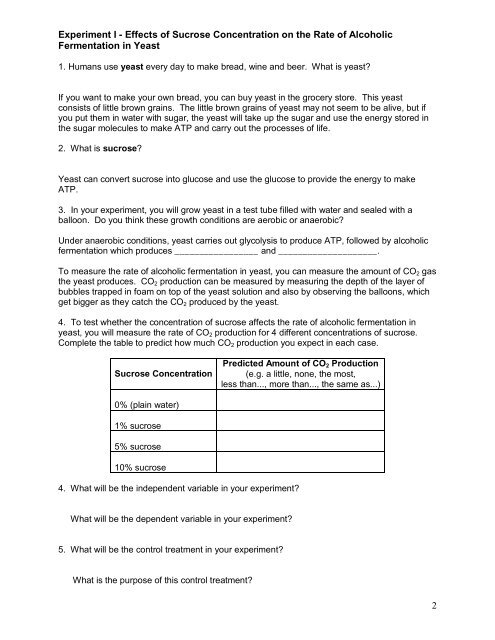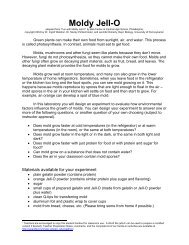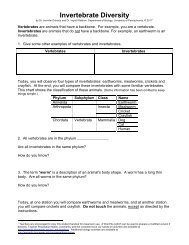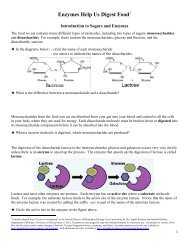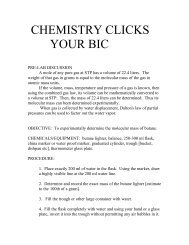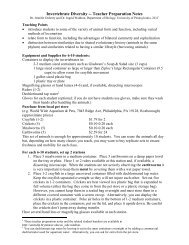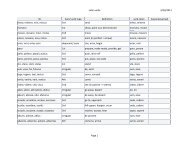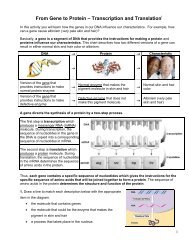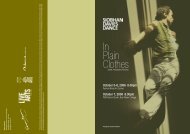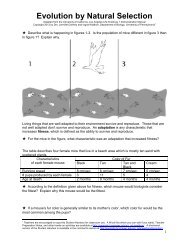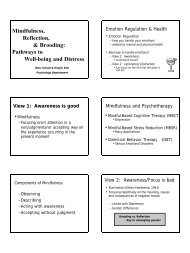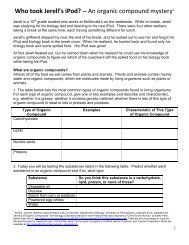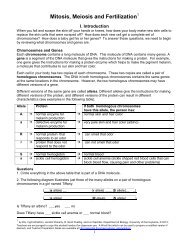Alcoholic Fermentation in Yeast - Serendip
Alcoholic Fermentation in Yeast - Serendip
Alcoholic Fermentation in Yeast - Serendip
You also want an ePaper? Increase the reach of your titles
YUMPU automatically turns print PDFs into web optimized ePapers that Google loves.
Experiment I - Effects of Sucrose Concentration on the Rate of <strong>Alcoholic</strong><strong>Fermentation</strong> <strong>in</strong> <strong>Yeast</strong>1. Humans use yeast every day to make bread, w<strong>in</strong>e and beer. What is yeast?If you want to make your own bread, you can buy yeast <strong>in</strong> the grocery store. This yeastconsists of little brown gra<strong>in</strong>s. The little brown gra<strong>in</strong>s of yeast may not seem to be alive, but ifyou put them <strong>in</strong> water with sugar, the yeast will take up the sugar and use the energy stored <strong>in</strong>the sugar molecules to make ATP and carry out the processes of life.2. What is sucrose?<strong>Yeast</strong> can convert sucrose <strong>in</strong>to glucose and use the glucose to provide the energy to makeATP.3. In your experiment, you will grow yeast <strong>in</strong> a test tube filled with water and sealed with aballoon. Do you th<strong>in</strong>k these growth conditions are aerobic or anaerobic?Under anaerobic conditions, yeast carries out glycolysis to produce ATP, followed by alcoholicfermentation which produces _________________ and ____________________.To measure the rate of alcoholic fermentation <strong>in</strong> yeast, you can measure the amount of CO 2 gasthe yeast produces. CO 2 production can be measured by measur<strong>in</strong>g the depth of the layer ofbubbles trapped <strong>in</strong> foam on top of the yeast solution and also by observ<strong>in</strong>g the balloons, whichget bigger as they catch the CO 2 produced by the yeast.4. To test whether the concentration of sucrose affects the rate of alcoholic fermentation <strong>in</strong>yeast, you will measure the rate of CO 2 production for 4 different concentrations of sucrose.Complete the table to predict how much CO 2 production you expect <strong>in</strong> each case.Sucrose ConcentrationPredicted Amount of CO 2 Production(e.g. a little, none, the most,less than..., more than..., the same as...)0% (pla<strong>in</strong> water)1% sucrose5% sucrose10% sucrose4. What will be the <strong>in</strong>dependent variable <strong>in</strong> your experiment?What will be the dependent variable <strong>in</strong> your experiment?5. What will be the control treatment <strong>in</strong> your experiment?What is the purpose of this control treatment?2


